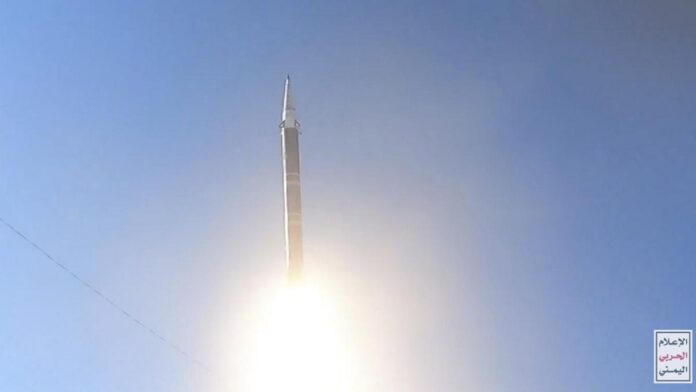Yemen Houthi rebels unveil solid-fuelled ‘Palestinian’ missile that resembles Iranian hypersonic missile
Footage released by the Houthis late Wednesday showed the Palestinian rocket mounted on a mobile launcher and rapidly rising into the air.

This frame from a video released by the Ansar Allah media office of Yemen’s Houthi rebels on Wednesday, June 5, 2024, shows a Palestinian missile launched from rebel-controlled territory in Yemen. | Photo credit: AP
Yemen’s Houthi rebels have unveiled a new solid-fuel missile in their arsenal, resembling one previously demonstrated by Iran, which Tehran has described as flying at hypersonic speeds.
ALSO READ : Israel’s Benjamin Netanyahu to address US Congress on July 24
Footage released by the Houthis late Wednesday showed the Palestinians mounted on a mobile launcher rising rapidly into the air with a plume of white smoke coming out of its engine. White smoke is common among solid-fuelled missiles.
Solid-fuelled missiles can be set up and fired faster than liquid-fuelled missiles. This is a major concern for the Houthis as their missile launch sites have been repeatedly targeted by the US and allied forces in recent months due to the rebels’ attacks on shipping through the Red Sea corridor. One such attack hit the Houthis before they were even able to launch their missiles.
For their part, the Houthis have what Palestine calls “locally manufactured” missiles. However, the Houthis are not known to have the capability to locally produce complex missiles and guidance systems in Yemen, the Arab world’s poorest country, which has been in the grip of war since the rebels seized the capital, Sanaa, nearly a decade ago.
However, during the war Iran has repeatedly supplied arms to the Houthis, despite a UN arms embargo. While Iran claims it does not supply arms to the Houthis, ships seized by the US and its allies have been found to contain Iranian weapons, missile fuel and components.
Iranian media reported the Palestinian launch and cited the Houthis as saying it was locally produced. However, design elements of the missile resemble other missiles developed by Iran’s paramilitary Revolutionary Guard. This includes a missile called Fattah, or “conqueror” in Persian.
Iran unveiled the missile last year and claimed it could reach speeds of Mach 15 – or 15 times the speed of sound. It touted the missile’s range as up to 1,400 kilometers (870 miles). That’s slightly less than the distance from Houthi-controlled areas of Yemen to Eilat, but the missiles can be reconfigured to extend their range.
In March, Russia’s state-run news agency RIA Novosti quoted an unnamed source as claiming the Houthis had a hypersonic missile.
“Although we cannot say for sure which variant ‘Palestine’ corresponds to, we can say with high certainty that it is an advanced and precision-guided (Guard)-developed solid propellant missile provided by Iran,” Fabian Hinz, a missile expert and research fellow at the International Institute for Strategic Studies, wrote.
Asked about the similarities between Palestine and its missiles, Iran’s mission to the United Nations told The Associated Press that Tehran has not engaged in any activities in violation of UN resolutions.
“Yemen’s military strength has grown since the start of the war … — a fact rooted in the intrinsic strength and valor of Ansar Allah,” the mission said, using another name for the Houthis.
Hypersonic weapons flying at speeds in excess of Mach 5 can pose serious challenges to missile defense systems because of their speed and maneuverability.
Ballistic missiles fly on trajectories in which anti-missile systems such as the US-made Patriot can predict their path and intercept them. The more irregular the flight path of a missile, such as a hypersonic missile with the ability to change direction, the more difficult it is to intercept.
It is believed that China and America are also trying to make these weapons. Russia claims that it has already used them.
It is still unclear how well the Palestine maneuvers and at what speed it travels.
Meanwhile on Thursday, a commercial ship in the southern Red Sea near the Bab al-Mandeb strait reported seeing explosions nearby, though no one was injured, the British military’s United Kingdom Maritime Trade Operations Centre said. Private security firm Embrey also reported explosions. Although no one immediately claimed responsibility for the attack, suspicion immediately fell on the Houthis.
The US military’s Central Command said the Houthis fired a ballistic missile into the Red Sea, while the US and its allies destroyed nine drones and two drone boats the previous day.
“There have been no reports of injuries or damage to U.S., coalition or commercial vessels,” it said.
#Yemens #Houthi #rebels #unveil #solidfuelled #Palestinian #missile #resembles #Iranian #hypersonic #missile





